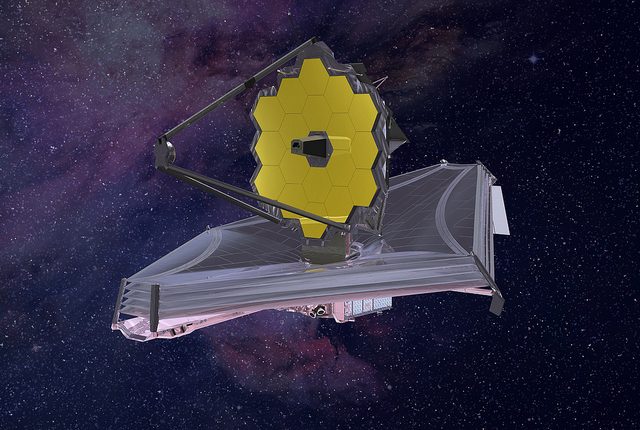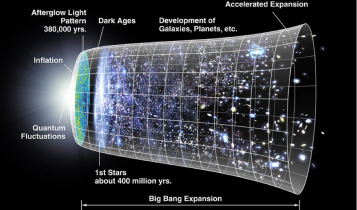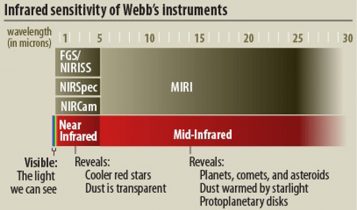Exploring the end of cosmic darkness with the James Webb Space Telescope
What happened in the beginning of time that gave way to the creation of atoms and influenced the history of mankind on planet earth? The James Webb Space Telescope (JWST) is being built to answer this question and much more.
Light was not always present in our universe and did not come into existence until about 100 million – 250 million years after the Big Bang. It is still unknown exactly when or how the first light source, stars, formed and what those stars looked like. One objective of the JWST mission is to discover and determine how the first luminous objects ended the cosmic dark age.

The JWST is a spaced-based observatory that will utilize infrared technology to look back 13.5 billion years and investigate the first star, planet and galaxy formation processes with an over-arching goal of discovering how chemical elements that support life came into existence.
“We’re looking to answer age-old questions,” said Laura Betz, JWST communications team lead. “Like how did our universe begin and evolve; how did galaxies, stars, and planets come to be; and are we alone.”
The JWST is designed to complement and extend the discoveries of the Hubble Space Telescope and will be the premier observatory for the next decade.
“For the first time, we will have Hubble’s clarity and resolution at infrared wavelengths,” said Space Telescope Science Institute Astronomer Joel Green.

Photo courtesy of NASA/ WMAP Science Team.
Every phase of cosmic history will be examined by the JWST, including: the very first galaxy formations in our Universe, the evolution of our solar system and the atmospheres of extrasolar planets.
“The James Webb Space Telescope is a mission with as broad a range of scientific questions as Hubble,” Green said. “Webb will answer a host of key questions about the formation of planets around many other stars – how long it takes, what kinds of planets form in what kinds of primordial disks, and what they are made out of – allowing us to understand what a ‘typical’ solar-like system would be, leading to predictions for the demographics of our galaxy.”
A major driving force of space astronomy over the next two decades is taking inventory of nearby habitable Earth-like planets.
“The Webb telescope will be able to characterize the atmospheres of the best neighboring candidates for inhabitable worlds,” said Space Telescope Science Institute News Director Ray Villard. “By the 2030s we’ll need a 10-meter class UV/optical telescope to do a large enough survey of exoplanets within 100 light-years to allow us to estimate the abundance of inhabitable worlds in our galaxy.”
NASA JWST web pages indicate the type of cutting edge technology that the JWST will use to fulfill its mission.
The primary imager for the JWST is the Near Infrared Camera (NIRCam), which will detect light within dust clouds to reveal the formation process of the earliest stars and galaxies. The NIRCam will be able to identify emerging planets by imaging the heated material rings that surround young stars. Star populations in nearby galaxies, young stars in the Milky Way and objects in the Kuiper Belt will also become visible.

The JWST will be able to study temperature, mass and chemical composition of objects with the Near Infrared Spectrograph (NICSpec), which disperses light from an object into a spectrum. Individual chemical elements can be identified from distinctive lines that atoms and molecules imprint on the spectrum of the object. Furthermore, the NICSpec can simultaneously observe up to 100 objects, the first of its kind in space.
The NICSpec also has coronagraphs that can take pictures of dimmer objects by blocking out the bright light of a central object. Planets that orbit stars could then be analyzed to determine their characteristics.
Other features of the JWST include the Mid-Infrared Instrument (MIRI), which will provide information about new physical details of distant objects from mid-infrared light emitted. MIRI is equipped with a wide-range, broadband imaging camera that will further the progress made in astrophotography.
Lastly, the Fine Guidance Sensor/ Near Infrared Imager and Slitless Spectrograph (FGS/NIRISS) on the JWST will guide the telescope and detect different wavelength range.
“But Webb is a general purpose observatory,” Green said. “For example, it will make enormous strides in understanding dark matter and its role in shaping galaxies [as well as] constraining the masses and types of black holes anchoring the centers of those galaxies.”
While JWST will provide answers to scientific inquiries, there is potential that entirely new types of objects and areas of study could come about.
Green said the most exciting aspect of the JWST will be exploring the unknown.
“When Hubble launched, no one had ever seen a planet around another star, and yet Hubble pioneered the measurement of gas in their atmospheres,” Green said. “No one had even hypothesized the existence of dark energy.”
The JWST is an international collaboration between NASA, the European Space Agency (ESA) and the Canadian Space Agency (CSA). NASA’s Goddard Space Flight Center manages the development effort, and the main industrial partner is Northrop Grumman.
The Space Telescope Science Institute will operate JWST after launch, which is set for October 2018.

